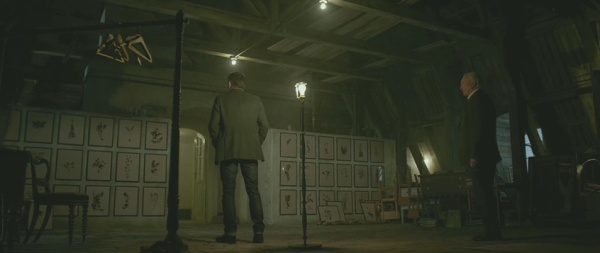2011 // USA // David Fincher // December 19, 2011 // Digital Theatrical Project (Wehrenberg Ronnies 20)
An argument can be made that David Fincher's adaptation of Steig Larsson's phenomenally popular pulp whodunit, The Girl with the Dragon Tattoo, is an exercise in style over substance. Certainly, the film’s opening credit sequence lends credence to this position: Yeah Yeah Yeahs vocalist Karen O growls out a cover of Led Zepellin’s "Immigrant Song" as oily black liquid oozes over human figures that are embraced and penetrated by writhing computer cables. It’s jarringly reminiscent of a James Bond opening, and perhaps a sly inter-textual joke at that, given that leading man Daniel Craig is serving as the current 007. The rest of the film is only moderately less brash.
However, such aggressive styling proves to be a tick-mark in the film’s favor, at least when one considers it alongside both the source material and Niel’s Arden Oplev’s comparatively flat, mirthless 2009 Swedish film adaptation. Under Oplev’s hand, Larsson’s grim tale of buried family secrets and socialist democracy gone freakishly awry was many things—workmanlike, satisfactory, disposable—but stylish it was not. The most valuable card up the sleeve of the 2009 film was Noomi Rapace, who embodied waifish, wounded hacker-sleuth Lisbeth Salander with eerie precision and a curious kind of dark magnetism.
Fincher’s take doesn’t add any appreciable depth to Larsson’s tale, and in this respect it is remarkably similar to the Swedish film. Screenwriter Steve Zallian wisely excises the Scandinavian politics and finance that dominated hefty stretches of the novel. Such components are arguable crucial for understanding the wider context of Larrson’s story, but what is digestible on the page is probably unworkable in a film. Zallian also trims and tweaks the narrative in other ways, mostly to make the story a little smoother and more symmetrical. From a thematic perspective, however, the new film is unsophisticated, offering little beyond the visceral appeal of an unsolved mystery, seat-squirming tension, and a streak of white-hot pseudo-feminist rage.
Insofar as this is the extent of what any version of the The Girl with the Dragon Tattoo could offer, David Fincher’s film is an unquestionably handsome and persuasive realization of the tale. It’s visually striking, crisply conveyed, and blessed with a lucid, seductive aesthetic and mood, which is more than one can say of most murder mysteries. Rooney Mara—slinky and wide-eyed beneath ghostly eyebrows—conveys her own variation of Lisbeth, more shrinking, awkward, and defensive than Rapace’s portrayal, but also more fearsome and razor-edged when provoked. Beyond Mara and Craig the film features a cast of familiar faces—Christopher Plummer, Stellan Skarsgård, and Robin Wright among them—as well as Swedish stars and long-lost character actors (Julian Sands!), all of whom acquit themselves well enough. (Perhaps the film’s only formal blunder is the vaguely accented English dialog, which is distracting given the explicit decision to retain the Swedish setting.)
The real stars here, however, are the craftsmen behind the film, a team of returning Fincher collaborators who manage to render a stomach-churning tale of rape, murder, and revenge as something deliriously attractive. Cinematographer Jeff Cronenweth bestows a familiar yellowish “greasy-gothic” look to most of the interior spaces, but elsewhere a chilly gray dominates, and appropriately so. The adroit editing from Kirk Baxter and Angus Wall—who have now cut the director’s past four films—keeps things humming along with enviable vigor and clarity, a necessary asset in a story so laden with exposition. Just as essential is the score by Trent Reznor and Atticus Ross, which effectively evokes an atmosphere of pure wrongness by layering plucked-out, discordant melodies over ambient droning and buzzing. These various visual and aural elements coalesce (perhaps “curdle” is a better term) into an atmosphere that is oppressive, gnawing, and eminently fitting for the tale. And therein lies the primary appeal of The Girl With a Dragon Tattoo: As a lurid, shallow thriller steeped in hideous beauty.





